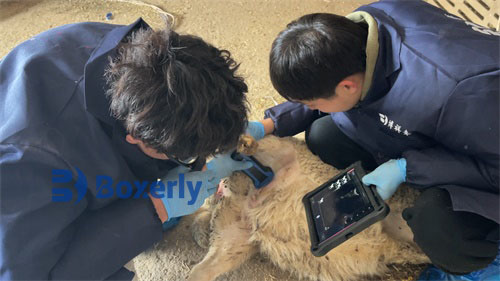The reproductive function of ewes is closely related to changes in sunlight, temperature, humidity, feed composition, and other external factors, which can synergistically affect the estrus of ewes. Especially, the development process of ewe follicles is greatly influenced by season and climate, and this pattern can be easily detected on sheep ultrasound. The number of estrus ewes is also related to the weather conditions.
The environmental temperature often has the most direct impact on the reproduction of sheep. The optimal temperature for breeding ewes is 10-15 ℃, and the feasible temperature range for production is 7-14%. If the temperature changes too much, it can cause heat or cold stress, which can affect the sexual behavior of ewes, the quantity and quality of eggs released, the survival of embryos, and cause a series of physiological reactions in ewes, affecting the growth and development of fetuses. This phenomenon can be observed in sheep using ultrasound.
The impact of heat stress on embryos mainly changes the microenvironment inside the uterus of ewes, interferes with the regulation of hormone levels, and affects the reproductive endocrine system. After the fertilized egg is subjected to heat stress in the early stage of cleavage, the mortality rate of early embryos will increase, and the death of embryos can also be well detected by B-ultrasound in sheep. During insemination, the temperature of the rectum and uterus is closely related to the conception rate. An increase in ambient temperature after mating can prevent fertilization.
According to reports, washing the fallopian tubes 3-5 days after insemination can cause 80% of eggs to undergo cleavage even under high temperature conditions in summer. Therefore, early embryo death caused by heat stress may occur after the embryo reaches the uterus and before pregnancy recognition. The regulatory response of ewes to heat stress can cause a decrease in blood flow to the uterus, leading to an increase in uterine temperature, and affecting the utilization of water, electrolytes, nutrients, and hormones by the uterus, resulting in an increase in early pregnancy embryo mortality.
In this case, it is necessary to frequently use sheep ultrasound examination. Infertility heat stress syndrome is mainly the result of various factors that regulate the uterine microenvironment working together. The temperature of the reproductive organs increases, causing changes in hormone balance and disrupting the precise balance and physiological synchronization between the embryo and the mother, leading to difficulties in implantation and infertility. In these cases, sheep should be regularly examined using B-ultrasound.








